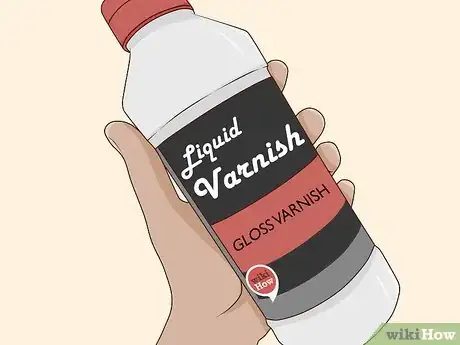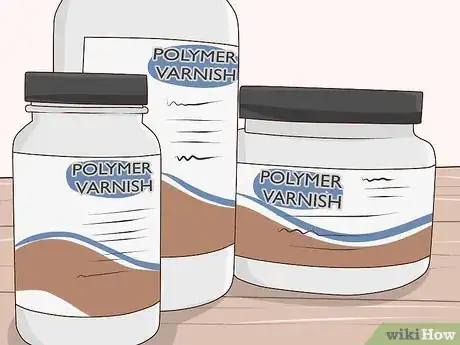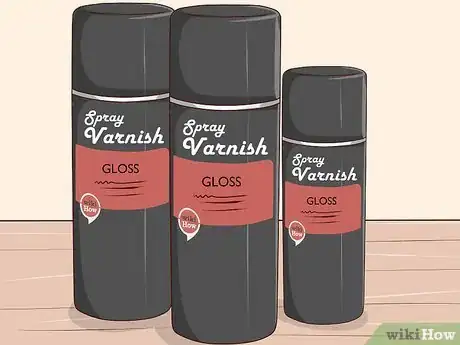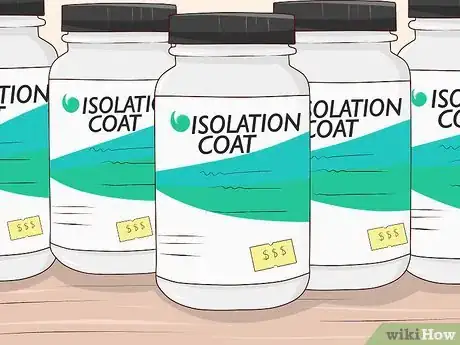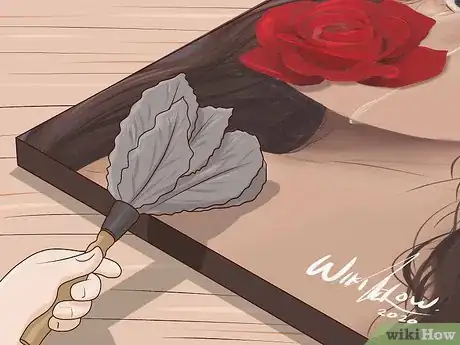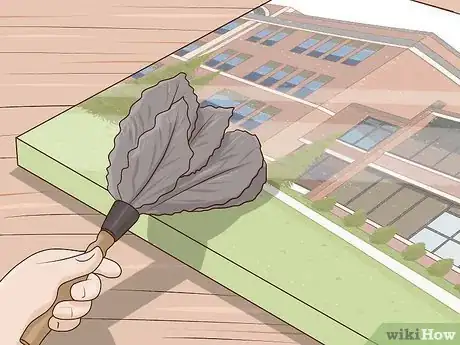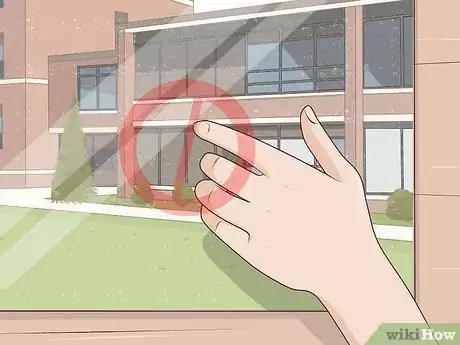This article was co-authored by Kelly Medford. Kelly Medford is an American painter based in Rome, Italy. She studied classical painting, drawing and printmaking both in the U.S. and in Italy. She works primarily en plein air on the streets of Rome, and also travels for private international collectors on commission. She founded Sketching Rome Tours in 2012 where she teaches sketchbook journaling to visitors of Rome. Kelly is a graduate of the Florence Academy of Art.
There are 7 references cited in this article, which can be found at the bottom of the page.
This article has been viewed 49,681 times.
When acrylic paintings aren't protected, they can slowly start to become discolored, cracked, or warped. Luckily, there are lots of ways to prevent this from happening. You can seal your canvas with varnish, protect it with a glass frame, and keep it in the right environment so it stays vibrant for years. With just a little bit of time and some protective measures, your acrylic painting will stay as good as new.
Steps
Choosing a Varnish
-
1Pick out a liquid varnish if your painting has a flat, uniform surface. Liquid varnishes that you apply using a paintbrush are the most well known and are great for acrylic paintings that aren’t super textured. Choose a liquid varnish that’s designed to go over acrylic paint from your local art or big box store.[1]
- A liquid varnish will likely give your painting a glossy finish, protecting it from dust, dirt, and other types of damage.
-
2Opt for an acrylic resin varnish if you want a glossy, clear finish. This type of varnish is super strong and great for protecting your canvas. Resin varnishes typically come in two liquid parts that you mix together equally before pouring it onto the canvas and spreading it evenly. Resin varnishes are toxic so it's best to use them in a well-ventilated area. [2]
- Purchase a resin varnish kit from your local craft store or online.
- If you use this type of varnish, you'll want to apply an isolation coat to protect your painting.
Advertisement -
3Select a polymer varnish for a non-toxic option. Polymer varnishes offer a great shine and protective layer like resin, though they're not quite as strong. Polymer varnishes are easy to apply with a paintbrush and are safer to use because they're not toxic. Look for a polymer varnish at your local craft store.[3]
- Pick out a matte polymer varnish if desired.
- The polymer varnish is easy to rinse out of brushes using soap and water.
- If you're applying a an isolation coat, you'll need to purchase a gloss for paint as well.
-
4Choose a spray varnish if your painting is textured. If you have an acrylic painting that has a lot of layers or distinct textures that you want to preserve, a spray varnish might be best. This type of varnish comes in a can and will leave a layer of protectant over your painting without any brush marks. Pick out a spray varnish that works on acrylic paint.
- If your acrylic painting has collage aspects or other types of media attached, a spray varnish is the best choice.
-
5Apply an isolation coat to protect your painting in case you remove the varnish. An isolation coat is often a coat of diluted gloss that separates the acrylic painting from the varnish. This way, if you decide to remove the varnish with a solvent, you won't accidentally remove the acrylic paint too. Mix 2 parts of a gel gloss with 1 part water and apply this to the canvas using a paintbrush before you apply your layer of varnish.[4]
- Purchase a gloss from your local craft store that's safe on acrylic paint.
Applying the Varnish to Your Canvas
-
1Wipe away any dust from your painting before applying the varnish. Use a feather duster or soft, clean paintbrush to swipe away any dust on your acrylic painting. This will make sure that the layer of varnish doesn’t trap any dust or dirt on the painting so you get the best look.[5]
- It’s also okay to use a lint-free soft cloth to wipe down your painting.
- Avoid wetting the cloth to wipe down your painting because the moisture might damage the acrylics.
-
2Place your canvas on a flat surface to varnish it with a paintbrush. If you're using a liquid varnish, cover a table or other surface where you’re working with plastic or layers of newspaper to protect it from the varnish. Set the canvas down on the table so your painting is horizontal.
- Clean your surface beforehand so dirt or liquids don't leak through the newspaper and onto your canvas.
-
3Brush the varnish onto the canvas in even layers. Use a flat, clean paintbrush to apply the varnish, dipping the brush into the liquid and wiping the excess off against the side of the can. Brush the varnish onto the canvas using even strokes. Start at the top left of the canvas and brush the varnish on using even strokes, moving to the far right of the canvas before working your way down.
- Applying multiple thin layers of the varnish instead of one thick one is best so you get even coverage.
- Follow the instructions on your can of varnish to make sure you apply it correctly.
-
4Hold a can of varnish 12 in (30 cm) away from the painting to spray it. Shake the can of varnish before you spray it so its contents are well combined. Spray the varnish across the canvas starting at the top of the painting and going from left to right in even rows. For extra protection, spray 2-3 layers of the varnish onto the canvas.
- Choose a well-ventilated area to spray your varnish.
- Continue shaking the can every couple of minutes as you’re spraying the canvas.
- Holding the spray 1 ft (0.30 m) from the canvas will make sure the varnish isn’t too concentrated in one area.
-
5Let the acrylic painting dry for several days in a dust-free space. Your specific type of varnish will tell you how long it takes to dry, but it’s best to let your painting sit for a few days just to be safe. Make sure your painting is drying in an area that isn’t super dusty or dirty so the dust doesn’t get into the drying varnish.[6]
Maintaining Acrylic Paintings
-
1Dust your acrylic painting with a feather duster to keep it clean. Swipe the feather duster gently over the canvas to get rid of any dust, moving from side to side evenly to be sure you clean the entire surface. The feather duster is gentle enough that it won’t damage your acrylic painting.[7]
- A large sable brush (a soft-bristled paintbrush) will work as a duster too.
- Bring your painting to a professional art cleaner if it's super dirty or you're worried about damaging it.
-
2Avoid touching your painting with your fingers. The oils on your skin can damage your acrylic painting over time, causing it to do things like discolor. As you’re cleaning your painting, be careful that you don’t touch its surface with your fingers to keep it in great shape.[8]
-
3Keep your artwork away from bright sunlight. Lots of exposure to the sun will make your acrylic painting fade over time so the colors aren’t as vibrant. When you hang your painting, choose a spot on the wall that gets less sunlight to keep the canvas in good shape.[9]
- For example, avoid placing the painting on the wall that’s facing a sunny window.
-
4Cover your painting in glass so it’s in a protective frame. Placing a frame with glass in it will protect your acrylic painting from dust and dirt, as well as any accidental touches. If you’re worried about sun damage, opt for a UV-protected plastic that looks similar to glass so your painting won’t fade as easily.[10]
-
5Keep your painting out of areas that are super dry or very humid. Humidity can cause your painting to warp while air that’s very dry can cause cracking or other damage. If the place where you’re putting the canvas is humid, use a dehumidifier to take the excess moisture out of the air, while a humidifier will help a super dry space.[11]
- An ideal humidity for the canvas is 55%. If you’re not sure what the humidity is in your space, purchase a hygrometer from a big box or home improvement store that will tell you.
-
6Store your acrylic painting in a cool, dark place. If you’re not hanging the acrylic painting at the moment, place it in an area that doesn’t get too much sunlight and that’s cool in temperature. Hotter temperatures can cause damage to the canvas like warping.[12]
- If you’re storing more than one acrylic painting together, place something between them like a clean board so they’re not directly touching.
-
7Bring your acrylic painting to a professional if you notice signs of aging. These signs might be things like discoloration, warping, or cracks in the paint. Instead of trying to fix these problems yourself, take your canvas to a professional painting restorer so they can take good care of your canvas.[13]
Expert Q&A
Did you know you can get expert answers for this article?
Unlock expert answers by supporting wikiHow
-
QuestionHow do you clean an acrylic painting on canvas?
 Kelly MedfordKelly Medford is an American painter based in Rome, Italy. She studied classical painting, drawing and printmaking both in the U.S. and in Italy. She works primarily en plein air on the streets of Rome, and also travels for private international collectors on commission. She founded Sketching Rome Tours in 2012 where she teaches sketchbook journaling to visitors of Rome. Kelly is a graduate of the Florence Academy of Art.
Kelly MedfordKelly Medford is an American painter based in Rome, Italy. She studied classical painting, drawing and printmaking both in the U.S. and in Italy. She works primarily en plein air on the streets of Rome, and also travels for private international collectors on commission. She founded Sketching Rome Tours in 2012 where she teaches sketchbook journaling to visitors of Rome. Kelly is a graduate of the Florence Academy of Art.
Professional Painter
Things You'll Need
Choosing a Varnish
- Liquid or spray acrylic varnish
- Paintbrush (optional)
- Gloss for isolation coat (optional)
- Cup (optional)
Applying the Varnish to Your Canvas
- Feather duster
- Plastic or newspaper
- Paintbrush
Maintaining Acrylic Paintings
- Feather duster
- Protective frame (optional)
References
- ↑ https://www.agora-gallery.com/advice/blog/2016/04/12/cleaning-and-protecting-paintings-what-you-need-to-know/
- ↑ https://www.si.edu/mci/english/learn_more/taking_care/acrylic_paintings.html
- ↑ https://www.youtube.com/watch?v=R6YJH3HAc6o#t=2m11s
- ↑ https://willkempartschool.com/how-you-can-charge-more-for-a-varnished-painting/
- ↑ Kelly Medford. Professional Painter. Expert Interview. 2 July 2019.
- ↑ Kelly Medford. Professional Painter. Expert Interview. 2 July 2019.
- ↑ Kelly Medford. Professional Painter. Expert Interview. 2 July 2019.
- ↑ https://www.artcons.udel.edu/mitra/Documents/MITRA_Storage_Exh_Handling.pdf
- ↑ https://www.artcons.udel.edu/mitra/Documents/MITRA_Storage_Exh_Handling.pdf
- ↑ https://www.agora-gallery.com/advice/blog/2016/04/12/cleaning-and-protecting-paintings-what-you-need-to-know/
- ↑ https://www.parkwestgallery.com/10-tips-how-to-protect-your-artwork-from-damage/
- ↑ https://www.artcons.udel.edu/mitra/Documents/MITRA_Storage_Exh_Handling.pdf
- ↑ https://www.agora-gallery.com/advice/blog/2016/04/12/cleaning-and-protecting-paintings-what-you-need-to-know/
